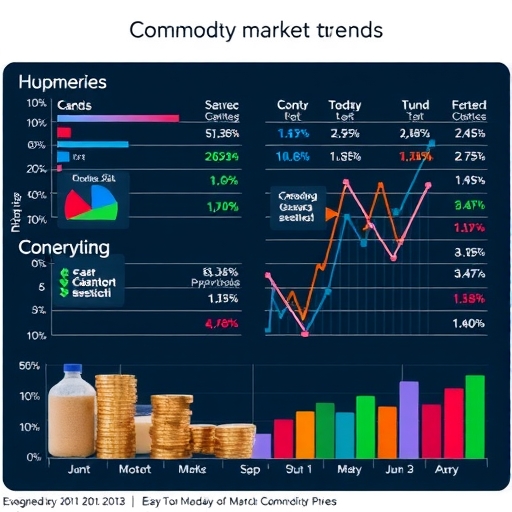Unlocking the Dow Jones Commodity Index: Your Guide to Diversification and Market Insights
Are you looking to understand how global markets influence your investments, particularly through the lens of tangible assets like oil, gold, or grains? In today’s dynamic financial landscape, exploring different asset classes is key to building a resilient portfolio. The Dow Jones Commodity Index (DJCI), managed by S&P Dow Jones Indices, stands as a pivotal benchmark in the world of commodity futures. This article will guide you through the DJCI’s unique structure, its role in reflecting market performance, and its strategic applications for investors like us, emphasizing its commitment to diversification and liquidity.  We’ll explore how this index helps us understand the broader commodity market, distinguish it from other benchmarks, and offer insights into global economic trends.
We’ll explore how this index helps us understand the broader commodity market, distinguish it from other benchmarks, and offer insights into global economic trends.
The DJCI’s Unique Framework: Diversification and Liquidity at its Core
When we talk about commodity indices, we’re discussing a way to track the performance of a basket of raw materials. But what makes the Dow Jones Commodity Index (DJCI) stand out? Unlike some of its counterparts, the DJCI is designed with a strong emphasis on both diversification and liquidity. Think of it like building a well-balanced meal: you want a variety of food groups, and you want ingredients that are easy to find and use. For the DJCI, this means carefully selecting and weighting various commodity futures contracts.
To truly grasp the DJCI’s unique design, it’s helpful to consider its foundational principles:
- It aims for broad market coverage to capture diverse economic signals.
- It prioritizes ease of trading, ensuring the index reflects liquid markets.
- It uses a transparent and objective methodology for consistent application.
The DJCI is a broad measure of the global commodity futures market, boasting a history spanning 26 years, though it was officially launched in its current form in 2014. As of its January 2025 reconstitution, it includes 29 different commodity futures contracts. These contracts are spread across three major sectors: agriculture and livestock, energy, and precious and industrial metals. This broad representation ensures that the index isn’t overly reliant on any single type of commodity, which is crucial for true diversification. We see this commitment in its equal-weighted approach across these sectors, ensuring no single sector dominates the index’s performance.
Here are the three major sectors covered by the DJCI, along with examples of commodities found within each:
| Sector | Key Characteristics | Example Commodities |
|---|---|---|
| Agriculture and Livestock | Sensitive to weather, global demand, and trade policies. | Corn, Wheat, Soybeans, Live Cattle |
| Energy | Influenced by geopolitical events, supply/demand dynamics, and economic growth. | Crude Oil, Natural Gas, Heating Oil |
| Precious and Industrial Metals | Precious metals act as safe havens; industrial metals tied to manufacturing and infrastructure. | Gold, Silver, Copper, Aluminum |
Its methodology is another key differentiator. The DJCI is liquidity-weighted, meaning that commodities that are more actively traded (and thus easier to buy and sell) receive a greater weighting within the index. This contrasts with other indices that might use world production as a weighting factor. To keep the index responsive to market changes, the DJCI undergoes monthly reweighting and annual rebalancing in January. This frequent adjustment helps maintain its liquidity profile and ensures it accurately reflects current market conditions. Furthermore, individual commodity components are capped at 32%, with remaining components capped at 17%, preventing any single commodity from having an outsized influence.
To summarize the DJCI’s core characteristics and methodology, let’s look at a quick overview:
- Broad Measure: Tracks the global commodity futures market.
- Diversified: Covers agriculture & livestock, energy, and precious & industrial metals sectors.
- Equal-Weighted: Sectors are equally weighted to prevent over-concentration.
- Liquidity-Weighted: Emphasizes actively traded commodities, proxied by total dollar value traded.
- Dynamic Adjustments: Features monthly reweighting and annual rebalancing in January.
- Component Caps: Individual commodities capped at 32%, others at 17%.
- Contract Type: Holds front-month futures contracts and rolls monthly.
How does this compare to other indices you might hear about, such as the S&P GSCI or the Bloomberg Commodity Index (BCOM)? While all aim to track commodities, their methodologies differ significantly. For instance, the S&P GSCI historically has a higher concentration in the energy sector, whereas the DJCI’s equal-weighted sectoral approach aims for broader balance. This distinct methodology is why many investors choose the DJCI for its specific blend of diversification and market responsiveness.
Understanding DJCI’s Market Performance and Global Influences
Commodity markets are inherently sensitive to global events, making them fascinating barometers of economic health. The performance of indices like the Dow Jones Commodity Index (DJCI) and its counterpart, the S&P GSCI, can tell us a lot about the wider economic climate. We’ve seen firsthand how major macroeconomic events can send ripples through these markets, affecting everything from energy prices to agricultural staples. 
Consider the impact of the COVID-19 pandemic. The drastic slowdown in global economic activity led to a significant drop in demand, especially for energy commodities like crude oil and natural gas. Industrial metals, crucial for manufacturing and construction, also saw volatility as supply chains were disrupted and production slowed. Conversely, as economies began to recover, particularly demand from Asia, we witnessed a rebound in many of these sectors. Geopolitical events, such as U.S.-China trade tensions, have also played a significant role, influencing the performance of agricultural commodities and various industrial metals due to tariffs and shifting trade policies. 
One of the most compelling reasons investors look to commodities is their potential as an inflation hedge. When the cost of living rises, the prices of raw materials often increase too. This makes commodity indices a valuable tool for protecting your purchasing power during periods of rising inflation. Furthermore, commodities can offer excellent diversification against traditional asset classes like equities (stocks) and bonds. When stocks or bonds are struggling, commodities might be performing well, helping to smooth out your portfolio’s overall returns. This dynamic relationship is why many financial experts recommend including commodities as part of a well-rounded investment strategy. 
Investors can gain exposure to the DJCI through several avenues:
- Exchange-Traded Funds (ETFs) and Exchange-Traded Notes (ETNs) that track the index.
- Futures contracts directly, for sophisticated investors.
- Managed funds and structured products that incorporate commodity exposure.
Let’s look at how different factors can influence commodity sectors within the DJCI:
- Global Economic Conditions: Strong economic growth generally boosts demand for industrial metals and energy. Economic slowdowns or recessions can lead to price declines.
- Geopolitical Events: Conflicts or trade disputes can disrupt supply chains, leading to price volatility in specific commodities.
- Weather Patterns: Extreme weather events directly impact agricultural commodities like corn, wheat, and soybeans, affecting supply and prices.
- Technological Advancements: Innovations in energy production or consumption can alter the demand landscape for traditional energy sources.
- Currency Fluctuations: Since many commodities are priced in U.S. dollars, a stronger dollar can make commodities more expensive for buyers using other currencies, potentially impacting demand.
Various global influences can significantly impact commodity prices, sometimes creating opportunities or risks:
| Influence Factor | Typical Impact on Commodity Prices | Affected DJCI Sectors |
|---|---|---|
| Interest Rate Hikes | Increases borrowing costs, potentially dampening demand; strengthens USD. | Broad impact, especially industrial metals and energy. |
| Supply Chain Disruptions | Can lead to shortages and price spikes. | Specific commodities, e.g., industrial metals, agriculture. |
| Technological Innovation | Can reduce demand for some traditional commodities or create new demand. | Energy (renewables), industrial metals (new materials). |
Understanding these influences helps us appreciate why commodity markets are so dynamic and why an index like the DJCI, with its broad exposure and active rebalancing, is a valuable tool for tracking these shifts.
Strategic Investment Applications: Beyond Traditional Assets
Why would you consider adding commodities to your investment portfolio? Beyond just tracking market movements, the Dow Jones Commodity Index (DJCI) offers several strategic applications that can enhance your investment strategy. One of the most significant benefits, as we’ve discussed, is its potential for inflation hedging. As the cost of living increases, the price of raw materials often follows suit. Including a diversified commodity index like the DJCI can help your portfolio maintain its value when inflation erodes the purchasing power of traditional assets like cash or fixed-income investments. This is a crucial consideration, especially in today’s economic environment.
Another powerful application is portfolio diversification. We often hear about diversifying across stocks and bonds, but what about adding a third pillar? Commodities historically have shown a low correlation with traditional asset classes. This means that when stocks or bonds are experiencing a downturn, commodities might be performing differently, potentially offsetting losses and reducing overall portfolio volatility. It’s like not putting all your eggs in one basket – by spreading your investments across different types of assets, you reduce your overall risk. Many investors employ dynamic multi-asset approaches, strategically allocating to commodities during specific market cycles to optimize returns and manage risk.
The conversation around commodity investing is also evolving to include environmental considerations. As global awareness of climate change and sustainable practices grows, so does the demand for investment products that align with these values. S&P Dow Jones Indices, for example, has explored initiatives like the S&P GSCI Climate Aware, which integrates environmental factors into commodity index design. While the core DJCI focuses on broad market exposure, this trend highlights a broader innovation within the commodity index space. For us, this means that future iterations or related indices might offer ways to invest in commodities with a greater focus on sustainability.
To illustrate the strategic benefits, consider this table:
| Investment Objective | How DJCI Can Help | Benefit to Your Portfolio |
|---|---|---|
| Inflation Hedging | Commodity prices tend to rise with inflation, protecting purchasing power. | Maintains real value of investments during inflationary periods. |
| Portfolio Diversification | Low correlation with equities and bonds. | Reduces overall portfolio volatility and risk. |
| Exposure to Real Assets | Direct investment in essential raw materials. | Provides a tangible asset class uncorrelated with financial assets. |
| Enhanced Returns | Potential for strong performance during commodity supercycles. | Opportunity for capital appreciation. |
By understanding these strategic applications, we can see that the DJCI is not just a passive tracker but an active component in a sophisticated investment strategy, helping investors navigate market cycles and achieve their financial goals.
The DJCI Ecosystem: Related Indices, Accessibility, and Key Updates
The Dow Jones Commodity Index (DJCI) is part of a larger family of commodity indices offered by S&P Dow Jones Indices, providing investors with a range of options to tailor their exposure. This “ecosystem” includes various related indices and product extensions designed to meet different investment objectives and risk appetites. Understanding these options and recent administrative updates is crucial for anyone engaging with commodity markets.
The DJCI ecosystem offers various options for tailored commodity exposure:
| Index Type | Description | Investment Utility |
|---|---|---|
| Core DJCI | Broad, diversified, liquidity-weighted exposure to 29 commodity futures. | Inflation hedging, general diversification. |
| DJCI Forward Indices | Uses longer-dated futures contracts (e.g., 6-month forward). | Less volatile exposure, insights into future price expectations. |
| Currency-Hedged DJCI | DJCI versions denominated and hedged in local currencies. | Mitigates foreign exchange risk for international investors. |
One interesting set of related indices are the “forward” versions of the DJCI, such as the DJCI 6 Month Forward. These indices measure performance based on futures contracts that are six months from the present date, rather than the immediate (front-month) contracts. What’s the benefit of this? They provide insights into future price expectations, which can be invaluable for sophisticated trading strategies or for investors looking for a less volatile exposure to commodities, as longer-dated contracts tend to be less reactive to immediate market fluctuations. There are also versions like the DJCI 5 Month Forward, 4 Month Forward, 3 Month Forward, and 2 Month Forward, offering a spectrum of forward-looking perspectives.
Accessibility is another key feature of the DJCI. Recognizing the global nature of commodity markets, the index is available in multiple currencies, including the U.S. Dollar (USD), Singapore Dollar (SGD), Japanese Yen (JPY), British Pound (GBP), Euro (EUR), Swiss Franc (CHF), Canadian Dollar (CAD), and Australian Dollar (AUD). Furthermore, corresponding currency-hedged versions are also available. This is important because it allows investors to manage foreign exchange risk within their commodity allocations. If you’re an investor in Japan, for example, you might prefer a JPY-hedged version to mitigate the impact of USD/JPY exchange rate fluctuations on your commodity returns.
S&P Dow Jones Indices, as the administrator, regularly consults with market participants and announces various updates to ensure the indices remain robust and reflective of market conditions. These updates can include adjustments to calculation methodologies, such as changes to adjustment factors for return-based index level calculations. For instance, annual announcements confirm the updated constituent weights for the DJCI and other indices like the S&P GSCI, which are critical for institutional investors and product providers tracking broad commodity performance. A recent procedural update involved the cessation of S&P Dow Jones Indices’ Real-Time Index AutoHolds, a detail important for those relying on real-time index data for trading and valuation purposes.
Here’s a snapshot of the DJCI ecosystem:
- Forward Indices: DJCI 6 Month Forward, DJCI 5 Month Forward, etc., offering insights into future price expectations.
- Currency Options: Available in USD, SGD, JPY, GBP, EUR, CHF, CAD, AUD.
- Currency-Hedged Versions: Allows for managing foreign exchange risk.
- Related Indices: Part of a broader family including various S&P GSCI sub-indices (e.g., S&P GSCI Energy & Metals, S&P GSCI Climate Aware).
- Governance: Subject to regular consultations and announcements by S&P Dow Jones Indices regarding methodology adjustments and weights.
- Key Updates: Procedural changes like the cessation of Real-Time Index AutoHolds.
This comprehensive ecosystem ensures that the DJCI remains a flexible and transparent benchmark, adapting to market needs and providing diverse ways for you to engage with the commodity landscape.
Conclusion
The Dow Jones Commodity Index (DJCI) offers a comprehensive and strategically relevant measure for understanding and investing in the global commodity futures market. We’ve seen how its unique methodology, prioritizing diversification and liquidity through equal-weighted sectoral allocation and monthly reweighting, sets it apart from other benchmarks. The DJCI provides valuable insights into how global economic conditions, from pandemics to trade tensions, impact the prices of essential raw materials. Furthermore, its role as a potential inflation hedge and a tool for portfolio diversification underscores its importance in a well-rounded investment strategy.
As S&P Dow Jones Indices continues to manage and innovate within the commodity index space, including considerations like environmental factors and offering various currency and forward versions, the DJCI remains a cornerstone for investors. By providing a balanced and responsive measure of the commodity market, it helps us navigate dynamic economic cycles and better understand the foundational elements of the global economy. Whether you’re a seasoned investor or just starting, understanding the DJCI empowers you to make more informed decisions about your financial future.
Disclaimer: This article is for informational and educational purposes only and does not constitute financial advice. Investing in commodity markets involves risks, including the potential loss of principal. Please consult with a qualified financial professional before making any investment decisions.
Frequently Asked Questions (FAQ)
Q: What is the primary goal of the Dow Jones Commodity Index’s (DJCI) methodology?
A: The DJCI’s primary goal is to provide a broad and balanced measure of the commodity futures market with a strong emphasis on diversification and liquidity. It achieves this through equal-weighted sector allocation, liquidity-weighted commodity components, and regular rebalancing to reflect current market conditions.
Q: How does the DJCI help investors hedge against inflation?
A: The DJCI can serve as an inflation hedge because commodity prices often tend to rise in periods of increasing inflation. By including diversified commodity exposure, investors can potentially protect the purchasing power of their portfolio when the cost of living and raw material prices are on the rise.
Q: What types of commodities are included in the DJCI?
A: The DJCI includes 29 different commodity futures contracts across three major sectors: agriculture and livestock (e.g., corn, wheat), energy (e.g., crude oil, natural gas), and precious and industrial metals (e.g., gold, copper). This broad range ensures comprehensive coverage of the global commodity market.



No responses yet